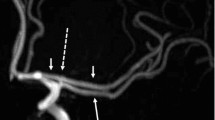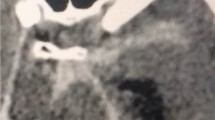Summary
The existence of the accessory middle cerebral artery (AMCA) is a rare anatomical variation with an estimated incidence of 0.31%. The embryological development of this artery is unknown. Three anatomical subtypes are described: in the type 1 variety the AMCA arises from the internal carotid artery; in the type 2, the AMCA originates from the proximal part of the anterior cerebral artery; in type 3, the AMCA arises from the distal part of the anterior cerebral artery. The use of endovascular techniques to treat cerebral vascular malformations requires knowledge of the anatomical subtype of AMCA and the brain regions it supplies (cortex, basal ganglia).
Résumé
L'artère cérébrale moyenne accessoire est une variété rare (0,31 %) dont l'embryologie n'est pas connue. On en décrit trois types anatomiques: 1) né de l'artère carotide interne, 2) né de l'artère cérébrale antérieure dans sa partie proximale, 3) né de l'artère cérébrale antérieure dans sa partie distale. Dans la pratique thérapeutique des malformations vasculaires cérébrales par navigation intra-vasculaire, le type de variété doit être connu ainsi que les territoires auxquels cette artère se distribue (cortex, noyaux gris⋯).
Similar content being viewed by others
References
Crompton MR (1962) The pathology of ruptured middle cerebral aneurysms with special reference to differences between the sexes. Lancet 2: 421–425
Falzon H (1977) L'artère cérébrale moyenne accessoire: étude angiographique à propos de 22 cas. Thèse Toulouse
Handa J, Seta K, Handa H (1968) Die akzessorische A. cerebri media. Fortschr Roentgenst 108: 539–541
Handa J, Shimi Zu Y, Mat Sudam (1970) The accessory middle cerebral artery: report of further two cases. Clin radiol 21: 415–416
Jain KK (1964) Some observations on the anatomy of the middle cerebral artery. Canad J Surg 7: 134–139
Krayenbuhl M, Yasargil MG (1964) Verschluss der arteria cerebralis media: ergebnisse der klinischen und katamnestichen untersuchungen. Schweiz Arch Neurol Psychiatr 94: 287–304
Lazorthes G, Gouazé A, Salamon G (1976) Vascularisation et circulation de l'encéphale. Anatomie descriptive et fonctionnelle. Tome 1, 115–118, Masson, Paris
Manelfe C, David J, Caussanel JP (1972) L'artère cérébrale moyenne accessoire. Colloque d'anatomie radiologique de la tête, Montpellier
Manelfe C, David J, Rascol A (1975) L'artère cérébrale moyenne accessoire. A propos de 17 cas. Société Française de Neuroradiologie, Paris
Newton TH, Potts G (1974) Radiology of the skull and brain. Angiography 2: 1172–1442
Paturet G (1964) Traité d'anatomie humaine. Masson, Paris
Teal JS, Rambaugh CL, Bergeron TR, Segall HD (1973) Anomalies of the middle cerebral artery: accessory artery, duplication and early bifurcation. Am J Roentgenol Radium Ther Nucl Med 118: 567–575
Author information
Authors and Affiliations
Rights and permissions
About this article
Cite this article
Abanou, A., Lasjaunias, P., Manelfe, C. et al. The accessory middle cerebral artery (AMCA). Diagnostic and therapeutic consequences. Anat. Clin 6, 305–309 (1984). https://doi.org/10.1007/BF01654463
Issue Date:
DOI: https://doi.org/10.1007/BF01654463




